page 4
Progressive Thinkers as of 5/8/2020
|
| ||||||||||||||||||||||||||||||||||||||||||||||||||||||||||||||||||||||||||||||||||||||||||||||||||||||||||||||||||||||||||||||||||||||||||||||||||||||
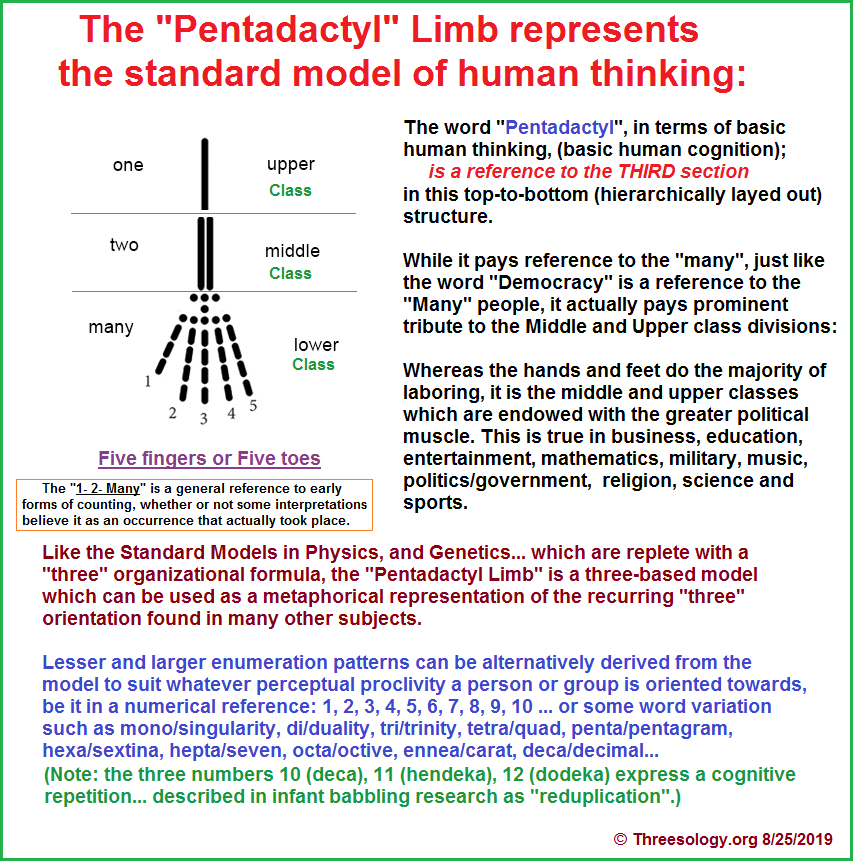
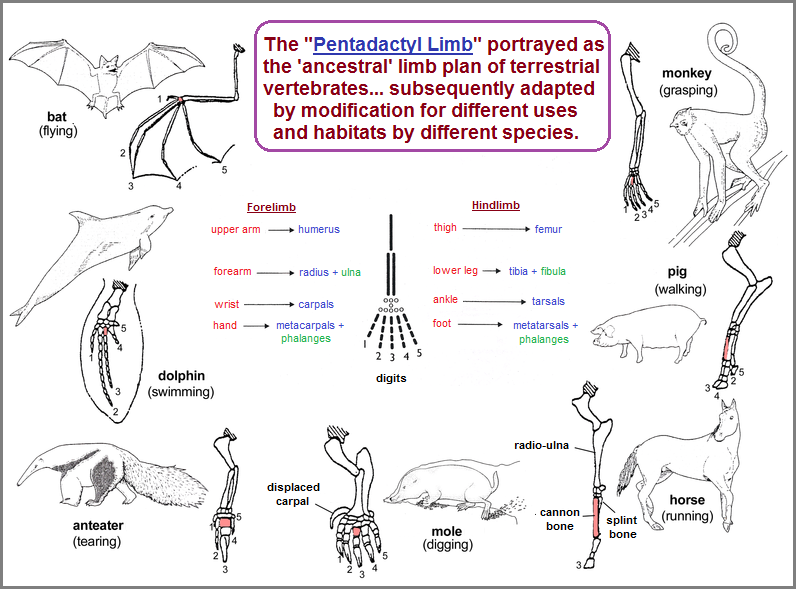
Our ideas can be viewed as stones piled upon one another, though some are more visible and used as mile markers called "laws" such as the three laws of movement and three laws of planetary movement, or three divisions of government, or three lights on traffic signals or three grades of gasoline, or three holes in bowling balls, or the three-patterned "I love you", or "Home Sweet Home", etc., The three, or two, or four, or five, etc., gives me the impression of a primitive sitting on the ground with a stone in hand, etching out some marks and/or lines by way of repetitive intention or spurious, one-of-a-kind designs like an artist who imagines they see something in a piece of rough stone, wood or other medium that they uncover and produce what others refer to as a piece of art, though the word "formula" or "equation" or "recipe", etc... may be used by others with their respective vernacular. Stonehenge presents us with a unique metaphor for the current discussion:
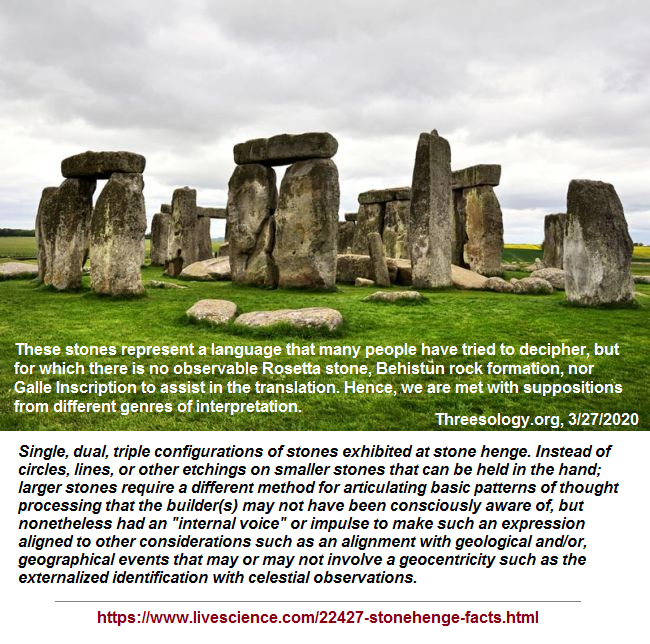
Let us also include another type of language metaphor from the field of Agriculture dealing with the idea of the Three Field System which was a progressive design over the two-field system, though some terrains (such as the around the Mediterranean) could not successfully accommodate the use of such a progressive alteration and were thus left in a two-patterned orientation. No doubt we see lingering two-patterned inclinations of thought processing today in the same region and others.

The division of items into groups-of-three can be found in the oddest of places. Take for example the following from page 48 of the November/December 2019 American Drycleaner publication we find the following reference to a comment of 50 years ago that was referring to a description entitled "The Good Old Days" of 100 years ago (making the date about 1869). It is reprinted from the North Judson (Indiana) News.
Note: I have included (in parenthesis) what I think is meant by words that are misspelled.
The "Receet (receipt? meaning recipe? ) for Washing Clothes."
- Bild (build) fire in back yard to heet (heat) kettle or rain water.
- Set tubs so smoke won't blow in eyes if wind is pert.
- Shave one hole (whole) cake lie (lye) soap in bilin (boiling) water.
- Sort things. Make three piles--- one pile white, one pile cullered (colored), one pile werk (work) britches and rags.
- Stur (stir) flour in cold water to smooth; thin down with bilin (boiling) water.
- Rub dirty spots on board (a ribbed wash board) , scrub hard, thin bile. ("thin bile" appears to refer to the use of bile for stain removal.)
- Take white things out of kettle with broomstick handle and then rench, (rinse) blew (blue/bluing process) and starch.
- Spread tee (tea) towels on grass.
- Hang old rags on fence.
- Pore (pour) rench (rinse) water in flower bed.
- Scrub porch with sopy (soapy) water.
- Turn tubs upside down.
- Go put on cleen (clean) dress, smooth hair with side combs, brew cup of tee (tea), and set and rest and rock a spell and count your blessings.
If a person has one book in their personal collection, it can be laid about anywhere, without it getting misplaced or lost amongst other reading materials. However, the more books one collects, the need for some system of ordering and placement is realized. Whereas we do not think of the three-patterned author- title- subject method as a product of Nature and is therefore not referred to as a Natural order, though in fact humans are, from which the idea arose. Each of the books contains some pattern that is used more often than others by a given author. In some instances the contents of a book may be encyclopedic with references to multiple subjects, many of which are described in terms with an enumerated pattern such a there being three rules, three laws, opposing forces, five results, three experimenters, four examples, etc... While the dominant pattern may not be signified by a number and the author themselves may be unaware that they in fact repeatedly use a particular pattern that can be enumerated, patterns exist and can be quantified. However, because in very many instances we can recognize a particular pattern by the same or multiple authors in different subjects, either indicates the human brain is configured with a similar architecture, and/or there exists an underlying pattern with language that all users thereof are inclined to adopt, whether they are aware of the influence or not.
If one thinks of language as a fundamental behavior and not a behavior of some fundamental characteristic, then the Noam Chomsky idea of Surface and Deep language structures will appear to be correct and definitive in understanding language. However, if language is like that of a reflex consistent with a type of physiology, than the idea of surface and deep language structures conceal themselves as being but a midway point of a structuralism that can not be more accurately understood without comparing multiple subjects, such as the identification of recurring fundamental patterns in biology, physics, mathematics, philosophy, art, music, biology, anatomy, genetics, etc... Language is thus just another stone on a heap of stones that have been collected together and sorted according to some perceived pattern(s). It is much like the many particles of atomic physics which are now being subjected to a type of analysis that is striving to develop a theoretical model of explanation for all of them, that we can alternatively describe as a search for a narrative enabling us to develop a better pile. Whereas when there was only three, the model was much easier than that which must incorporate three quarks, and the overall three families of fundamental particles, each assigned with a particular "personality", so to speak, like a family of children exhibiting different traits of expression.
While the usage of the words "surface" and "deep" in Noam Chomsky's transformational-generative grammar would seem to deal with a definitive parameter of language structure, this is true only if one limits themselves to the property line boundaries of language as demarked by Chomsky and other linguists. They have set themselves up as lifeguards around a pool that is labeled Language that you can swim in only if you follow their rules. However, this is true for all subjects, including those which emphasize an allowance of creativity and originality, so long as they reigning leadership is the dominant arbiter of what is meant as creativity and originality. Yet if one views language as but a type of territory amongst other available terrains in a much larger area of consideration, then the methodology of surveying language in the Chomskian manner is appreciably domain-centric... like a king having his kingdom placed in the center of a map as the central region of concern and consideration, because the typical distance being traveled (in this case intellectually), is but a short journey; like those in the past whose life from birth to death existed within a confined area of a safe harbor of exploration. Thus another kingdom's inhabitants never came to be aware of others unless they were subjected to traders, minstrel travelers or assaults... of which there are occurrences thereof from time to time in the realms of different subjects by those advancing alternative views that we can otherwise label as supportive goods, supportive services, supportive entertainment, diversionary contests or threat, indirect or direct. Nonetheless, even if one does travel beyond a given territory of linguistics and defines it as an alternative perspective, we all too often see that a type of musical chairs game is being played with rules that also define a set parameter in which participants are forced to play.
Stratificational grammar, system of grammatical analysis in which language is viewed as a network of relationships and linguistic structure is considered to be made up of several structural layers, or strata. Stratificational grammar derives in part from glossematics and in part from American structuralism. It was put forward in the United States as one of the principal alternatives to transformational grammar, but it has had much less impact elsewhere on linguistic theory and practice.
Stratificational Grammar is a structural framework developed by Sydney Lamb in the 1960s that aims to provide an account of the structure of language, the relationship between meaning and speech.
The framework is called stratificational because one of its chief features is its treatment of linguistic structure as comprising several structural layers or strata. Its earlier form, in the late fifties and early sixties, followed the tradition of structural linguistics in treating the structure as composed of linguistic elements and their relationships. In the mid-sixties, work on the relationships among linguistic units revealed that when the relationships are fully plotted, the units actually disappear, so that the entire structure consists of a network of relationships.
In keeping with the idea of stratification, the network as a whole can be considered to consist of multiple sub-networks, called stratal systems. Operation of the system, for speaking and understanding, takes the form of activation passing through the network. Multiple pathways are invariably active in parallel at any time. By the end of the twentieth century, stratification and the relationship of realization had become widely recognized, and the theory's distinctiveness lay in its focus on the conception of linguistic structure as a network of relationships. Accordingly, it increasingly became referred to as relational network theory rather than stratificational theory. Beginning in 1971 it was also called cognitive linguistics, but when that term became more widely used for a variety of other theories during the eighties and nineties, the more distinctive term neurocognitive linguistics began to be used. This latter term is in keeping with the hypothesis that relational networks are related to neural networks of the brain. This hypothesis was explored in Lamb (1999).
The word "standard" used in the label "Standard Cognitive Model" refers to what appears to be a recurring cognitive structure that language can provide us with tell-tale indications of a theme exposed by the addition of enumeration. However, let us recall that language development is said to have a Pre-linguistic state followed by a Linguistic stage, that we Threesologists would add to by claiming the existence of a Post-linguistic stage, since we have noted that physiology displays a recurring "threes" theme such as the three Germ layers (Endoderm- Mesoderm- Ectoderm), and we have the idea of a developmental three- patterned sequence to the brain labeled the Triune brain. This present model is paying witness to a pattern-of-three that is seen in Sociology, Vertebrate anatomy and Mathematics, described with a type of language that... when language is looked at more closely, also presents us with the same pattern; though those who study language may use the term "structure" and get caught up in the interlaced bars of scaffolding and overlook the three levels of platforming. The following excerpt from the 1989 New American Desk Encyclopedia page 738 on Linguists may be helpful for some readers at this point:
Linguistics: the scientific study language. Interest in how language works and the differences among languages extends back to ancient times (witness the attention given to grammar in the classical curriculum). In the late Middle Ages and Renaissance, the study of biblical and other ancient texts marked the emergence of what is now called historical, or diachronic linguistics.
In the 19th century comparative language studies (comparative biology) and analysis of grammatical systems led the way to modern synchronic linguistics (i.e., the study of contemporary language use); the great 19th-century theorist Karl Wilhelm von Humboldt anticipated structuralist and behaviorist concepts vital in the 20th-century linguistics. The first modern linguist was Ferdinand de Saussure, whose major work (1916) introduced linguistic structuralism, i.e., the thesis that there exists a structure underlying a language distinct from the sounds or utterances made; elaboration of this view has dominated all later linguistics.
In Europe, the influential Prague school of linguists has tried to combine study of structure with study of the many functions performed by language. American linguists (including the following examples, emphasized descriptive methods of analyzing languages:
American structuralism also became distinctly behavioristic, and thus deliberately excluded Semantics (study of meaning) or theories about it or how the mind produced language. With Zellig S. Harris and his student Noam Chomsky, the tide turned.
Chomsky's system of transformational-generative grammar, as he developed it in the 1960s, postulates a deep structure to language that corresponds to universal features in the human mind, and the rules of the system aim to demonstrate how sound is related to meaning.
Technically, linguistics may be considered as having three aspects:
- The study of sound (phonology).
- The study of word formation (morphology).
- The study of syntax and vocabulary (which are called the "lexicon").
Many branches of linguistics reach into other fields of study, including Psycholinguistics (concerned mainly with language acquisition), anthropological and Sociolinguistics (which relate language to culture and socialization), applied linguistics (which focuses on methods of teaching languages), dialectology and geographical linguistics, and so on.
With respect to Chomsky's Transformational-generative grammar, let's take a look at a definition from the Wikipedia:
Noam Chomsky's 1965 book Aspects of the Theory of Syntax developed the idea that each sentence in a language has two levels of representation: a deep structure and a surface structure.[1][2] The deep structure represents the core semantic relations of a sentence and is mapped onto the surface structure, which follows the phonological form of the sentence very closely, via transformations. However, the concept of transformations had been proposed prior to the development of deep structure to increase the mathematical and descriptive power of context-free grammars. Deep structure was developed largely for technical reasons related to early semantic theory. Chomsky emphasized the importance of modern formal mathematical devices in the development of grammatical theory:
But the fundamental reason for [the] inadequacy of traditional grammars is a more technical one. Although it was well understood that linguistic processes are in some sense "creative," the technical devices for expressing a system of recursive processes were simply not available until much more recently. In fact, a real understanding of how a language can (in Humboldt's words) "make infinite use of finite means" has developed only within the last thirty years, in the course of studies in the foundations of mathematics. —Aspects of the Theory of Syntax
The "deep" and "surface" represent a dichotomy referencing a personal mindset preference. Whereas he describes a need for the implementation of a mathematical tool, it is not in the context of analyzing language patterns amongst different subject areas. It is a means to analyze language, but not the patterns of language as a vehicle. However, we can perceive the usage of a dialectical framework by enlarging the perception of Chomsky:
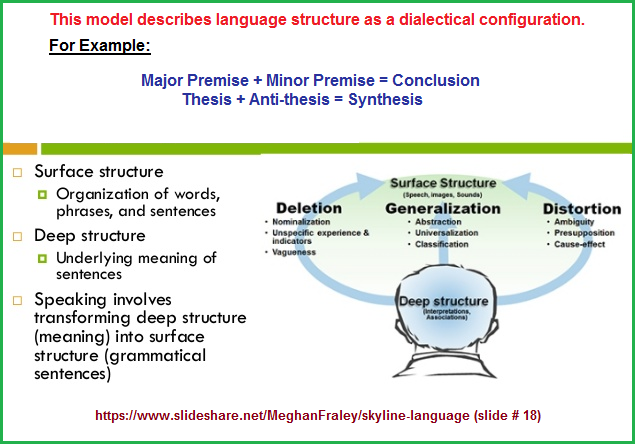
In his sense of explanation, the surface and deep structures of language can be viewed as an opinion about an internalized developmental sequence that does not elaborate on a third structure, just as we can see early life forms with a two-germ layer configuration and more complex life forms with a three-germ layer formula, with a one-germ layer structure suggested as being represented by the sponges... the sponges being an old and more primitive animal.
(Here is a relevant discussion on this topic: Evolutionary origin of gastrulation: insights from sponge development Nagayasu Nakanishi, Shunsuke Sogabe & Bernard M Degnan)
Sponges consist of four classes - Demospongiae, Calcarea, Homoscleromorpha and Hexactinellida - of simple animals that share a common body organisation. As juveniles and adults, they are sessile, tri-layered animals that lack true muscles and nerves. Sponges possess an internal network of canals and ciliated choanocyte chambers lined with epithelial cells, primarily endopinacocytes and choanocytes, and are separated from the external environment by another epithelial layer, the exopinacoderm (image below; hexactinellids are constructed as a syncytium). Sandwiched between these epithelial layers is the collagenous mesohyl, which is enriched with multiple types of amoebocytes, including the pluripotent stem cell type, the archeocyte. Water currents created by ciliary beating in choanocyte chambers enable most of the physiological requirements of sponges, including feeding, respiration, excretion and reproduction. This juvenile/adult body plan is the outcome of the dramatic reorganisation of the radially-symmetrical, bi- or trilayered larva at metamorphosis.
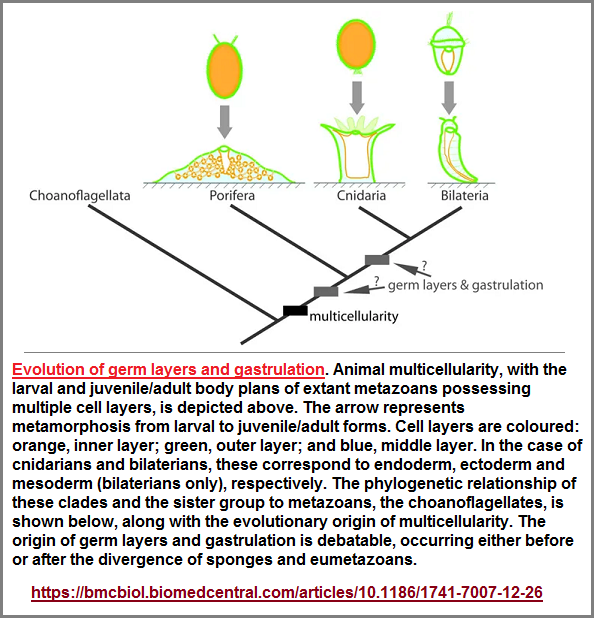
If the ideas of a surface and deep structure can somehow be viewed as being analogically similar to the one and two-germ layer scenarios, in this sense there is or will be a third structure in the making; if we are accurate in our description of language having a basic biologically relevant dimension to it. The words surface and deep could easily be translated into representing those surface and deep structures which are derived from the different germ layers:
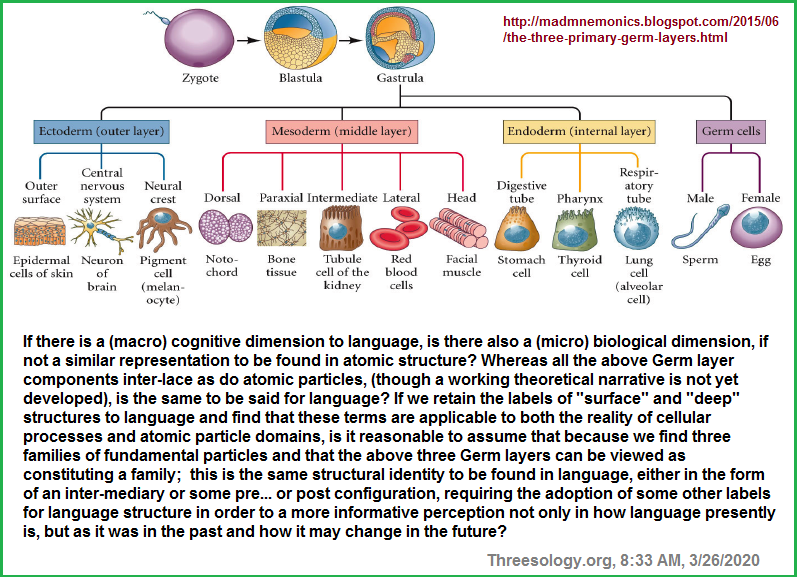
- Ectoderm: The outer layer, produces the cells of the epidermis and the nervous system.
- Endoderm: The inner layer, produces the lining of the digestive tube and its associated organs (pancreas, liver, lungs etc.)
- Mesoderm:The middle layer (forms last), gives rise to several organs (heart, kidney, gonads), connective tissues (bone, muscles, tendons, blood vessels), and blood cells.
The formation of the germ layers is one of the earliest embryonic events to subdivide multicellular embryos into a few compartments. In Xenopus laevis, the spatial domains of three germ layers are largely separated along the animal-vegetal axis even before gastrulation; ectoderm in the animal pole region; mesoderm in the equatorial region and endoderm in the vegetal pole region.
Generation of the germ layers along the animal-vegetal axis in Xenopus laevis. Yasuo H., Lemaire P.
In presenting such correlations as those suggested in the foregoing image, we need to strive for some viable perspective. For example, we should not expect language to exhibit a similar "threes"-layer or division theme as either atomic particles or germ layers, since the three particle families, we might assume, are billions of years old.
,All in all we know of three different types of lepton pairs. In the same way there are also three different quark-pairs. To the question why there are three families of elementary particles we do not have a fundamental answer today. We only know that there are no more than three types of neutrinos with masses smaller than half the Z-boson mass.
Why are there three families of elementary particles?
As for the age of the 3 germ layers as an assembled construct of three and not as a previous two or one structure along their developmental path, we will make a guess that they occurred sometime during the development of multi-celluarity, which is around 600 to 900 million years ago, though the reader may well find references closer to 800 and 900 million years ago.
Language, on the other hand, developed between 50 and 150,000 years ago according to different estimates, although how we define language determines when it actually started. If we decide that behavioral similarities between apes and humans is all that is necessary to establish a link which involves anatomically related precursors to language, then we might want to consider language to have begun much earlier in time. This article has a relevant discussion: Introduction to Part II: The biology of language evolution: anatomy, genetics and neurology, Kathleen R. Gibson and Maggie Tallerman
Here is a timeline of several different events involving patterns-of-three:
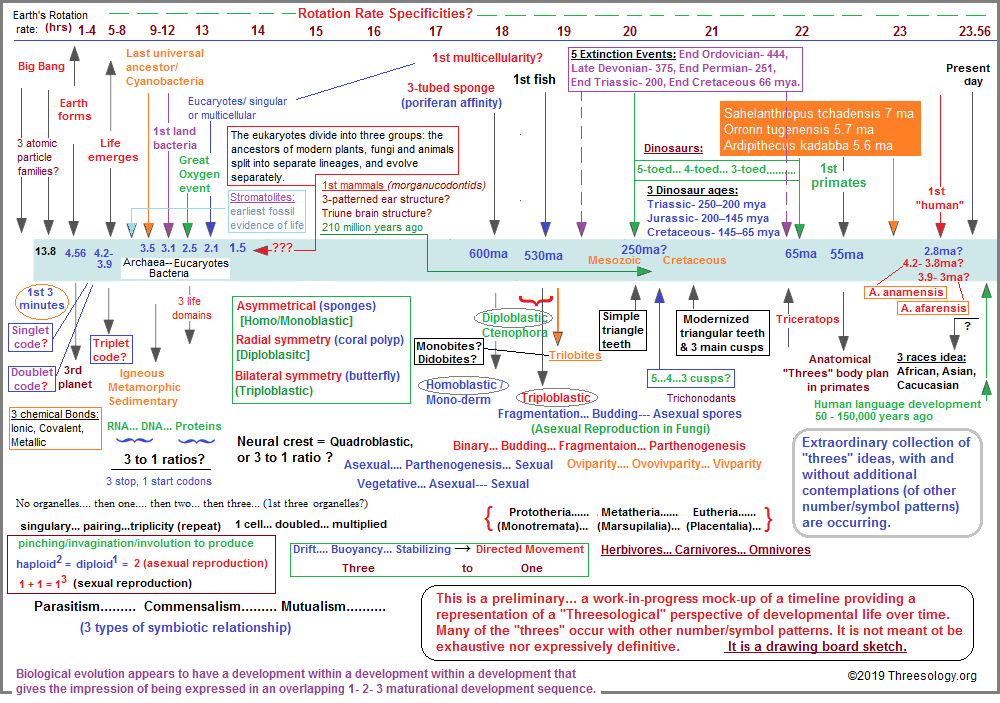
To reiterate and encapsulate:
- 3 families of fundamental particles arose billions of years ago.
- 3 Germ layers arose around 600 to 900 years ago (by using a generously large playing field)
- 3, word-order language development occurred somewhere in the 50 to 150,000 years ago range. (Assuming that the beginnings of language began with an underlying pattern-of three usage, whether the words were simple grunts or other utterances.)
Note: I am claiming that early utterances of language "expression" may have had a pattern(s) because infants babble and make other vocal sounds in which patterns can be detected. Clearly there must have been a "stage" or at least moment in which single sounds were emitted, and then double sounds, and triple sounds, whether we insist these were merely repetitions or "reduplications" or not. This is not to say that a pattern-of-three was dominant, but the fact that we use a dominant three-pattern such as in describing word order (subject- object- verb), attests to the consideration that language is directed along this orientation.
Let me also include the development of the three-patterned ear and triune brain with mammals, which came into being somewhere in the 210 million years ago range.
Since language arose late on the developmental stage when compared to the 3 families of atomic particles and 3 germ layers, it is reasonable to consider that it is at present in a formative mode and is transitioning into a more decisive three-patterned architecture which will affect thinking patterns. If language has an underlying structure which emphasizes a two-patterned alignment, ideas will necessary follow suit, because the language equipment facilitates a two-patterned usage much easier than a three-patterned alignment which places stress on the structure to accommodate the desire to stretch out the configuration. Like a bifurcated balloon that is being forced to accommodate a fluid or gas that requires a third compartment and not simply an enlargement of one or two as it is designed. The plasticity of language may extend into the ability for it to be evolutionarily designed to be restructured to fit within the environmental designs of other three-patterned formulas being exhibited. Hence, when we recognize a recurring pattern-of-three orientation in multiple subject areas as indicated by language, it stands to consider that there is one or more influences of this design. Likewise, we must also consider is that atomic particles do not exist in three families but that our language describes it as such in concert with a brain configuration which deduces this idea because a pattern-of-three gets its influence from that which is forced to comply to events in an inclemently deteriorating environment... as a survival mechanism that is little more than a temporary gesture.
Yet, the so called underlying structure of Language does not belong to language. As such, we need to view the underlying structures of genetics and atomic nuclei, as seen through the filtering mechanism of the human mind, as not belonging to them either. They are merely different models for pattern representation that we may use numbers, words or other symbols to decipher and illustrate with. Similarly, when we identify a "standard cognitive model" such as is described in the foregoing illustration, the fact that we can see a similar pattern in multiple disciplines, along with a recurring limitation of patterns being used, describes a structure we have barely scratched the surface in not only describing, but learning how to think differently in our approaches to an analysis thereof. However, this is not to say that the human species is able to perceive, much less comprehend the structure. An analogy that can be used is to describe religions as language that attempts to describe and analyze the notion of god (and other ideas), but is not itself god, despite some claiming that their language is god such as the phrase: In the beginning was the word, the word was with god and the word was (a) god. If god is an underlying pattern central to all religions, then religions are just different models trying to illustrate a pattern called god, but is not necessarily equipped to do so in any accurate way, because religion restricts the analysis to religion. Hence, likewise, the underlying structure or pattern(s) of language do not imply that language is the best equipped to perceive, display and analyze such pattern(s). Language, like DNA, is a vehicle of a code that is wrongly interpreted to mean that such vehicles originated the code as well. Contrary to our presumed intuition about DNA and language generation, DNA like language, does not replicate itself like a parental figure. They are offspring. Both reference replication that they are a part of. Mimicry, like reflexes and instincts is not replication, it is reflection that may occur due to diffraction or absorption. Language like biological cells have internal, underlying structures. And though the structures may have underlying patterns which re-occur, this does not tell us how the patterns came to be there nor why a certain pattern(s) repeat, and what the repetition means, if it has and is changing over time.
When we identify the same recurring pattern found in language as we do in other subjects, we need to adopt a larger, broader methodological approach in order to incorporate a sense of acknowledging the need for using tools more applicable to the task.
Whereas one may study linguistics within the defined parameter of linguistics, one is not encouraged to make comparisons of identified patterns with those in other subjects. Let us first take a brief description of Linguistics followed by one for Philology:
Linguistics is the scientific study of language. The word was first used in the middle of the 19th century to emphasize the difference between a newer approach to the study of language that was then developing and the more traditional approach of philology. The differences were and are largely matters of attitude, emphasis, and purpose. The philologist is concerned primarily with the historical development of languages as it is manifest in written texts and in the context of the associated literature and culture. The linguist, though he may be interested in written texts and in the development of languages through time, tends to give priority to spoken languages and to the problems of analyzing them as they operate at a given point in time.
The field of linguistics may be divided in terms of three dichotomies:
- Synchronic versus Diachronic: A synchronic description of a language describes the language as it is at a given time; a diachronic description is concerned with the historical development of the language and the structural changes that have taken place in it.
- Theoretical versus Applied: The goal of theoretical linguistics is the construction of a general theory of the structure of language or of a general theoretical framework for the description of languages; the aim of applied linguistics is the application of the findings and techniques of the scientific study of language to practical tasks, especially to the elaboration of improved methods of language teaching.
- Microlinguistics versus Macrolinguistics: The terms microlinguistics and macrolinguistics are not yet well established, and they are, in fact, used here purely for convenience. The former refers to a narrower and the latter to a much broader view of the scope of linguistics. According to the microlinguistic view, languages should be analyzed for their own sake and without reference to their social function, to the manner in which they are acquired by children, to the psychological mechanisms that underlie the production and reception of speech, to the literary and the aesthetic or communicative function of language, and so on. In contrast, macrolinguistics embraces all of these aspects of language. Various areas within macrolinguistics have been given terminological recognition: psycholinguistics, sociolinguistics, anthropological linguistics, dialectology, mathematical and computational linguistics, and stylistics. Macrolinguistics should not be identified with applied linguistics. The application of linguistic methods and concepts to language teaching may well involve other disciplines in a way that microlinguistics does not. But there is, in principle, a theoretical aspect to every part of macrolinguistics, no less than to microlinguistics.
Eric P. Hamp: Robert Maynard Hutchins Distinguished Service Professor Emeritus of Linguistics, of Psychology, and of Slavic Languages; Director, Center for Balkan and Slavic Studies, University of Chicago. Coeditor of Readings in Linguistics, I & II.
"linguistics." Encyclopædia Britannica Ultimate Reference Suite, 2013. (Britannica.com: Linguistics)
Traditionally, Philology refers to the study of the history of language, including the historical study of literary texts. It is also called comparative philology when the emphasis is on the comparison of the historical states of different languages. The philological tradition is one of painstaking textual analysis, often related to literary history and using a fairly traditional descriptive framework. It has been largely supplanted by modern linguistics, which studies historical data more selectively as part of the discussion of broader issues in linguistic theory, such as the nature of language change. However, some philologists continue to work outside a linguistics frame of reference, and their influence can be seen in the names of some university departments (e.g., Romance philology) and journals.
David Crystal: Independent scholar. Author of Language Death; Language Play; English as a Global Language.
"philology." Encyclopædia Britannica. (Britannica.com: Philology)
In as much as cognitive science recognizes the need to include various disciplines in order to "compare notes" so to speak, like different detectives working on the same case from their respective vantage points; the initiating interests (stepping stones) in the study of language (syntax, phonology, morphology, semantics, grammar, origination of vocal sounds such as by way of imitating natural sounds [onomatopoeia], etc...) developed into a very cultish mindset (like so many other interests do) in that like a religion whose members want to create a hierarchy of exception and importance, members become divided into those who are more devout and those who are less; with the "more" and "less" arbitrarily defined by those who want to include themselves in the ruling majority or produce a minority over the majority. Hence, parameters of what is to be studied, how it is to be studied, where, when, by whom, for what purpose and in the say such studies are to be expressed, all become resources that are controlled and dispensed under the guidance and will of a select few, like all businesses, governments and religions try to effect within their respective domains of activity, and will work together in a symbiotic fashion to keep the public in check if this is most advantageous for a given period of time for a given purpose to force others to accept the prevailing view point of whatever leadership is in control.
The study of language like all other subjects that are or will come to be created as an interest of study are developed by way of a stepping stone process that may then set the stones in an alignment which produces a path that others want to travel on and thereby become owned by those who then create an institution that will teach (for a fee) the way in which one is to travel the stones. The path may then become a street, then a boulevard, a highway and then a freeway; typically with tolls and erected bridges set up as tasks to be crossed and ceremonially recognized as a social accomplishment. And those who think to take a short cut by offering an alternative path cited as a viewpoint, may then be arranged as a divisions or sub-division from the main road. Hence, like an offspring, they are endowed with a name that includes the parent source. However, it is untypical in any subject area for a path to be created which provides a map towards revamping the role of the parent, such as in the case of describing the study of language as itself being an offshoot of a subject that is not or has not been as yet identified. Hence, linguistics remains as the governing distributor from which other ideas are associated, and no idea is used to portray the study of language as being but a path of a more productive channel of travel.
In other words, the study of language is viewed as the study of something quite fundamental involving integrated constituent characteristics, like an atom shown to have sub-atomic particles, but is not viewed nor questioned as to its supposed dominance as a basic structure of behavior. Another analogy is to describe language being viewed as a primary disease and not a symptom, or as a time-piece instead of as a gear within a watch or clock. In some sense, language is being viewed as the originator of itself, but I see language as but one of several different behaviors that are themselves not actually fundamental characteristics. To me, they form a type of dot to dot figure with language but a single dot that some people choose to use as the beginning dot from which they explore and thus call it not only their home base, but a home base from which all others use... even if they don't realize it like so-called self-pronounced language experts... whose expertise is within the parameters of a particular style of study.
If one attempts to introduce the usage of a different language (vernacular) in the study of some subject which involves language, what they perceive may well be interpreted to support the vantage point of someone else's interests, thus leading to a tower of Babel, so to speak. If everyone in the tower is claiming to be an expert and all the experts are disagreeing, who then does the public turn to if not themselves... because they are generally speaking the same language. A language being contorted by so-called experts wanting to arrange the common vernacular to suit the advocacy of their desired expertise. The public simply goes along with whomever is enabling them to maintain the desired level of existence within their respective social and cultural spheres. In this respect, the common language of experts develops into its own culture and they adopt the concerted philosophy in accord with the interests of those who assist them in their desired livelihoods that involves an ability to pursue their research. They could be dead wrong in all that they uncover and conceptualize, but it doesn't matter since they are in a position which provides a means for an existence acceptable to the formula under which they co-exist with family, friends, neighbors, relatives and colleagues... even if some of them disagree with their views, it nonetheless a developed culture of agreed upon disagreement that doesn't provoke anyone to start a war or invite destruction in order to force others to agree with someone's particular view point.
Language allows us to identify patterns within the parameters of a given language usage. Yet how we define a word may not be how it will be defined in the next decade, nor even guarantee a given word, description or belief will even be used as a defining means of interpreting perceptions. The foregoing illustration of a "Standard" Cognitive model is intended to convey that there exists a repetition of human mental activity that is recognized but not necessarily acknowledge on a conscious level to the extent it provides the impetus to create a larger appreciation for how widespread and deep the pattern exists. Yet, in acknowledging the presence of a recurring pattern-of-three, what exactly are we looking at? Is it little more than a linguistic representation of a cognitive mimicry, or is there some more fundamental three-patterned activity which is affecting the recurring construction? For example, would living on the 4th planet... in this case Mars, influence biology to develop a quadruple code in DNA? Would sub-atomic particle formations involve an other-than three-patterned configuration, or lift human consciousness out of its present ideological conformations and conservations? Or will it be necessary to intentionally alter the design of life on the genetic level? For example, can we produce a sentient being with a quintuplet genetic code? Or how about a code with a 1,000 signification? Will humanity have to remove itself from this solar system, this galaxy, if it is to remove the apparent constraints being exhibited by the handful of number patterns being repeated by cognitive processes?
Some of the research done in every subject area s pretty simplistic. They all have simple patterns that use different indicators such as numbers that may or may not be aligned with letters which may be used to reference direction, and thus represent geometric orientations... all of which may then be given labels from which larger references are annotated. For example, not only do we see patterns that we can align with number labels, but also the usage of geometrical directions (such as from the bottom- up, or from the top- down, but also from side to side, and 'off the path' [diagonally], not to mention geometric configurations such as when simplistically expressed as a well-"rounded" education, a "straight" person, a "square" person, love "triangle," multi-dimensional, fractionated, fractal, etc...) While such expressions point to simply notions, the recurring usage of a limited set of such notions is not being routinely identified and then linked with other similarly referenced limitations found in other subjects, thus providing a larger view of cognitive processing using language. Yet, like numbers, language is said to provide an unlimited range of possibility, even if that possibility is never taken advantage of. It is enough for some to think that they have access to an unlimited resource, unknowing that such a conceptualization is an illusion-creating mechanism which causes research to digress from a realization of itself as a symptom of an incremental degradation... a degradation which can cause presumed developmental advances or evolution to emerge, but go unrecognized as a burst of energy like the occasional sun spot that flares up as the Sun's energy continues to erode.
However, again, in all such configurations we frequently see an absence of recognizing the existence of limitations. For example, the recurrence of patterns-of-three (or two, four, five, six, seven, eight, nine, etc...,) can be grouped together to highlight the fact that we do not routinely use larger numbers or many of the numbers available to us in the infinity of numbers which exist. The "One- Two- Many" description of the Pentadactyl limb is a recurring theme seen in multiple subjects, often obscured by the language and application in a given context. Human ego very often gets in the way because it wants a projected image of some imagined one-of-a-kind uniqueness, the idea that it is not subjected to a limitation that "the sky's the limit" (so to speak) and not that it is parroting some other subject's personality or other characterization. Nonetheless, the recognition that we are seeing the same patterns in all the different subjects, and that the quantity of patterns is a very small set, indicates we are being constrained. What is causing the constraint and why needs to be determined. Since we are dealing with language in our descriptions, another (repeated) look at language from various perspectives can be helpful to some researchers. Repetition is sometimes necessary to solidify perception along a given path and direction that can be lost with the introduction of various analogies.) From the Britannica, comparative Linguistics is defined as:
The study of the relationships or correspondences between two or more languages and the techniques used to discover whether the languages have a common ancestor. An assumption important to the comparative method is the Neo-grammarian principle that the laws governing sound change are regular and have no exceptions that cannot be accounted for by some other regular phenomenon of language. The initial sounds, although different, correspond regularly according to the pattern discovered by Jacob Grimm and named Grimm's law; the other differences can be explained by other regular sound changes.
Date of Origination: Saturday, 14th March 2020... 6:11 AM
Date of Initial Posting: Sunday, 10th May 2020... 9:01 AM
Updated Posting: Sunday, 1tth May, 2020... 8:32 AM